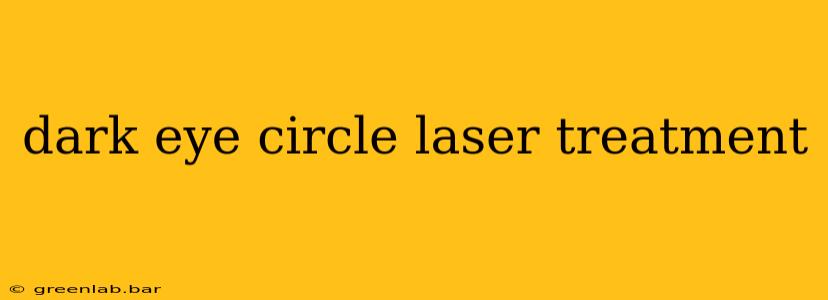Dark circles under the eyes are a common cosmetic concern affecting millions. While makeup can provide temporary camouflage, many seek more permanent solutions. Laser treatment has emerged as a popular option, offering potential improvements in the appearance of dark circles. This comprehensive guide explores the science behind dark eye circle laser treatment, its effectiveness, potential side effects, and what you should consider before undergoing the procedure.
Understanding the Causes of Dark Circles
Before diving into treatment options, it's crucial to understand the underlying causes of dark circles. These can vary significantly from person to person, and a proper diagnosis is essential for determining the best course of action. Common causes include:
- Genetics: In some cases, dark circles are simply inherited traits, passed down through families. Thin skin under the eyes can exacerbate this genetic predisposition.
- Hyperpigmentation: Increased melanin production in the skin can lead to darkening under the eyes. This is often influenced by sun exposure, hormonal changes, and certain medical conditions.
- Vascular Issues: Dilated blood vessels under the eyes can also contribute to a darkened appearance. This is often seen as a bluish or purplish discoloration.
- Lack of Sleep and Fatigue: Insufficient sleep can exacerbate the appearance of dark circles, making existing issues more prominent.
- Aging: As we age, the skin around our eyes becomes thinner and loses collagen and elastin, leading to increased visibility of underlying blood vessels and pigmentation.
- Allergies: Allergic reactions can cause inflammation and swelling around the eyes, contributing to dark circles.
Laser Treatment Options for Dark Circles
Several types of laser treatments target the different causes of dark circles:
1. Nd:YAG Laser:
This laser is primarily used to address vascular issues contributing to dark circles. By targeting the dilated blood vessels, it can reduce the bluish or purplish discoloration.
2. Fractional Laser Resurfacing:
This technique stimulates collagen production, improving skin texture and reducing the appearance of fine lines and wrinkles that can accentuate dark circles. It also helps with hyperpigmentation by promoting skin cell turnover.
3. Intense Pulsed Light (IPL) Therapy:
IPL therapy is effective in treating hyperpigmentation by breaking down melanin. It can help lighten the dark discoloration under the eyes.
What to Expect During and After Treatment
The procedure itself is generally quick and minimally invasive. A topical anesthetic might be applied to numb the area. The recovery time varies depending on the type of laser used and the individual's skin. You can expect some redness and swelling immediately after the treatment, which typically subsides within a few days. Your doctor will provide specific aftercare instructions to optimize healing and minimize potential side effects.
Potential Side Effects and Risks
While generally safe, laser treatments for dark circles carry some potential risks:
- Redness and Swelling: This is common and usually temporary.
- Bruising: Minor bruising is possible.
- Hypopigmentation or Hyperpigmentation: In rare cases, the skin may become lighter or darker than surrounding areas.
- Infection: The risk of infection is minimal with proper aftercare.
- Scarring: Scarring is uncommon but possible.
It's crucial to discuss these potential risks with your dermatologist or a qualified medical professional before undergoing treatment.
Choosing the Right Laser Treatment
The best laser treatment for dark circles depends on the underlying cause and your individual skin type. A thorough consultation with a qualified dermatologist or plastic surgeon is essential to determine the most suitable approach and manage expectations realistically. They will evaluate your skin, discuss your medical history, and help you decide on the most appropriate treatment plan.
Maintaining Results
Maintaining the results of your dark circle laser treatment involves following your doctor's recommendations and adopting a healthy lifestyle. This includes:
- Sun Protection: Daily use of sunscreen with a high SPF is crucial to prevent further hyperpigmentation.
- Hydration: Staying well-hydrated helps maintain skin health.
- Adequate Sleep: Getting sufficient rest helps reduce the appearance of dark circles.
By combining laser treatment with a healthy lifestyle, you can achieve and maintain long-lasting improvements in the appearance of your dark circles. Remember, consistency is key to maintaining optimal results.
Disclaimer: This information is intended for educational purposes only and should not be considered medical advice. Always consult with a qualified healthcare professional before making any decisions related to your health or treatment.

